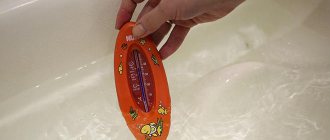Rating: No rating
Of course, breast milk is the best thing a mother can give to a newborn baby. But nowadays there are many objective reasons why a mother cannot breastfeed. And then the question arises about using a bottle.
By and large, it doesn’t matter what’s in it, it’s important to know how to properly feed a newborn baby with formula or mother’s milk from a bottle. Remember that bottle feeding doesn't make you a bad mom and has benefits. After all, anyone can feed a baby from a bottle: dad, grandma, and even grandpa.
How and when to feed your baby
As with breastfeeding, a baby using artificial formula is also fed on demand. This will make it possible to prevent the child from worrying due to hunger. The norms for formula consumption by age and the number of recommended feedings are usually written on cans of infant formula.
Do not be upset if the baby does not cope with the prescribed norm at one time; next time he will require feeding earlier. Bottle feeding is as intimate and touching a moment as breastfeeding. Both baby and mother should be calm.
The mother's task is to provide the baby with pleasant physical rest and eye contact during feeding.
Tips for parents
Tips for parents on feeding positions:
- Sometimes it happens that mom's hands get tired. In this case, you can use fixing devices - feeding pillows, bolsters or a simple towel.
With their help, the baby and bottle can be positioned anatomically correctly. However, it is important to maintain eye and tactile contact.Under no circumstances should you leave your baby alone if he is busy with a bottle!
- Regardless of the position, the emotional comfort of the mother or the one who is feeding him at the moment is also important for the child to receive maximum benefit from feeding.
- You don't need to feed him if you are irritated, upset or angry.
- Also, you should not start feeding if something is bothering the baby. It is important to eliminate the cause of anxiety and then feed the baby.
- The child should feel only love, care and warmth. During the feeding period, a quiet, calm conversation will help the baby and his digestion.
Preparing to Bottle Feed
Before you bottle feed your baby, you need to purchase a bottle and a pacifier for it.
When choosing a bottle it is important:
- the material from which the bottle is made (it can be glass or plastic - glass is more durable, and plastic is lighter and more convenient);
- There must be divisions on the bottle to determine the amount eaten.
Buy several bottles , then you can use different bottles for water and mixture; for home and walking. The purchased bottle must be thoroughly washed and sterilized. Nipples are usually sold complete with bottles and have age recommendations (depending on the age, the baby sucks faster or slower, respectively, the hole will be larger or smaller). If the hole is chosen correctly, the baby will eat the prescribed amount in 15-20 minutes. The pacifier is also washed and sterilized.
When selecting a mixture, the pediatrician is your main assistant and advisor. He will help you choose the mixture that best suits the baby’s physiological characteristics, as well as the one that best suits the baby’s age.
Check the temperature of the formula before feeding . Usually a little of the mixture is dripped onto the wrist. If the droplet is neither hot nor cold, you can start feeding.
Choosing a bottle for your baby
When choosing a bottle, you need to pay attention to the material of manufacture. The bottles are:
- Glass. Such dishes are heavy and can break, but they are easy to keep clean and have a long service life.
- Plastic. The advantages of plastic dishes for babies are ease of use and the ability of the baby to hold them independently. When choosing plastic, give preference to a harder material.
The shape of the bottles can be standard, curly, anti-colic and wide-necked.
Anti-colic bottles
If you have problems with swallowing air, as well as to prevent them, use anti-colic bottles. Thanks to the special design, the baby will only absorb formula or milk from the bottle, and the risk of swallowing air will be reduced to zero. Such devices are:
- protozoa, with an air channel in the nipple;
- complex systems with a twist-off bottom with a slit.
Variety of nipples
The success of feeding depends on the correct choice of nipple. Depending on the material, nipples can be rubber or silicone. Rubber models are quite soft, but fragile and have an odor. Silicone ones are more durable, moreover, they do not change color when exposed to sunlight, and they are easy to disinfect. The shape of nipples is anatomical, round and large in diameter, similar to female breasts. An important point when choosing a nipple is the speed of food flow. The number of holes and their size in the upper part of the nipple regulate the flow of milk. When choosing, consider the baby’s age and appetite. Manufacturers classify products on a 6-point scale from 0 to 5. For infants, nipples with 1 small hole are selected, for older children - with several.
Features of feeding
So, the bottle and nipple have been purchased and sterilized, the formula has been prepared, let’s find out how to properly hold the bottle when feeding a newborn. The bottle should be held at an angle of 45°, while constantly checking that the nipple is filled with the mixture. This position of the bottle prevents excess air from entering the baby's tummy. When air gets in, it creates a false feeling of fullness; in addition, it causes bloating and colic. To avoid this, hold your baby after column feeding. In this position, excess air will be burped.
Bottle feeding technique
- Press the pacifier to the baby's lower lip - he will open his mouth slightly and begin to suck. If the baby does not open his mouth, move the pacifier over the baby's lips. When the baby begins to suck, make sure that his tongue is under the nipple and his lips are wrapped around the wide part of the nipple.
- Each baby suckles at his own pace. Don't try to influence this process. In addition to satiation during feeding, the newborn also satisfies its need for sucking.
- Make sure that the hole in the nipple is optimal. You'll know something is wrong if your baby starts to choke or gets tired quickly when feeding.
- It is considered normal if 10-20 grams of the mixture remain uneaten.
- After feeding, allow your baby to burp up any excess air.
- Pat your baby on the back while feeding and make eye contact with him. This is a pleasant feeling not only for the baby, but also for you.
In what position to bottle feed a newborn?
The feeding position should suit both the baby and his mother well. Let's look at the algorithm for several postures for feeding newborns.
We advise you to read which bottle to buy for a newborn.
So that he doesn't burp
To prevent the baby from burping, he should be on his side while eating. Many experts recommend that it be the left side of the body. To prevent the child from moving, he should be secured with pillows, bolsters or special clamps.
The mother can water the baby while sitting or also lie on her side next to the baby. At the same time, it is important to maintain eye contact with the baby and constantly monitor the filling of the nipple with the mixture.
So that he doesn't choke
To avoid choking, the mother should sit on a chair or sofa, lean her back well and bend her legs. Next, position the baby so that his butt lies on one mother’s hip, and his back on the other. In this case, the child’s head will be on the bent elbow. With an unoccupied hand, the mother holds the bottle of drink, and also constantly monitors the angle of its inclination and the speed of delivery of the mixture.
Did you know? Most people are susceptible to “infantile amnesia,” meaning they remember virtually nothing until the age of 3. However, early feelings of warmth, tenderness and happiness remain with them throughout their lives.
So as not to choke
To prevent the child from choking, the food bottle should be placed at an angle of 45°. This is the most comfortable slope, setting the optimal rate of flow of the mixture.
a - incorrect tilt of the bottle 90°, b - correct tilt of the bottle, 45°
It is important to control the position of the baby's head so that baby food does not get into the respiratory tract. With this method, it is better for mom to sit next to the crib. Because prolonged unnatural body position will lead to pain in the spine.
Video: How to properly bottle feed your baby
To prevent air from getting in
The entry of air into the baby's stomach leads to a false feeling of fullness and problems with digestion, so the entry of air with food should be minimized. To do this, you should stop every 10-15 minutes and remove the bottle so that the baby can burp.
Also, less air will enter the stomach if you feed the baby in a semi-upright position, for which:
- take the child in your arms;
- place its head on the bend of the elbow;
- hold the baby close to you with your palm;
- with the other hand, give the bottle so that the nipple is completely filled with liquid;
- When bubbles appear, remove the bottle from the mouth and briefly lift the baby upright.
Important! When placing your baby upright to burp, be sure to place a napkin or towel over your shoulder to prevent the air and food mixture from getting on your clothes.
How to feed while lying down
You should not feed the baby in an even horizontal position , this may result in milk getting into the middle ear and the development of inflammation. Therefore, it is better for the baby’s head to be slightly raised and his body to be at an angle. In this case, the parent must constantly monitor the feeding process and the angle of the bottle.
Baby's position
For feeding to go well, not only formula, bottles and nipples are important, but also the position in which you will bottle feed your newborn. First, make yourself comfortable. May you have good support for your back and legs.
Position your baby on your lap so that his head is slightly higher than his body. To do this, bend your arm (usually your left) at the elbow and place the baby’s head in the fold, while making sure that the spine and head are on the same line, without kinks.
That is, the position of the baby will be the same as during breastfeeding. Important! Never feed your baby in a horizontal position. He might choke!
After feeding
When a child is under one year old, it is especially important to carefully observe hygiene when feeding him from a bottle. The baby has practically no immunity - it is at the stage of formation and does not perform protective functions. Failure to follow the rules for caring for bottles, nipples, and other devices used when feeding infants can lead to negative consequences, manifested in stomach upsets or diarrhea.
We suggest you read: What vegetables can a nursing mother of a newborn eat?
When sterilizing children's equipment, it is recommended to use filtered or bottled water - this way it is possible to prevent the appearance of a specific coating on the equipment.
Sterilization is carried out using one of the following methods:
- Using a special sterilizer for baby bottles.
- Using a microwave oven. The equipment is placed in a glass pan, filled with water, and closed with a lid. Place the pan in the microwave and turn it on for 10 minutes.
- Simple boiling. The equipment that needs to be sterilized is loaded into a pan and placed on the fire. Bring to a boil, continue the process for 5-10 minutes.
Useful practical recommendations:
- Carefully process and sterilize all children's equipment after each use.
- Do not use abrasive cleaners or antibacterial cleaners when cleaning children's equipment from contamination.
- Carefully check the integrity of the nipple; to do this, it must be pulled in different directions.
- Dispose of children's equipment when you notice the first signs of failure - obvious wear, scratches or cracks.
- Replace the pacifier and sippy cup every 90 days.
- Do not use a microwave oven to heat baby food. There is a possibility of uneven heating of the product, which can lead to burns to the baby’s mouth when feeding it.
- Before giving formula or expressed milk to your baby, carefully monitor the temperature of the product.
Breaks during feeding
No matter how hard you try to avoid air getting in during feeding, it's likely that some will get in.
If your baby has eaten very little and is restless, put the bottle aside and stand the baby in a “column” so that he can burp air.
You can place the baby on your shoulder , holding his head and placing his arms on your back. In this case, you can lightly tap on the back. To avoid staining your clothes, place your baby's bib or towel over your shoulder.
Breast milk in bottles
In the modern world, mother is a very busy person. Even if she does not work and devotes all her time to caring for the baby, it is not always possible to practice real breastfeeding. Irregular milk supply, lack of time and other factors affect the mother’s desire to feed her baby breast milk.
Now the industry of products for young mothers and children takes into account this need and you can feed your baby breast milk from a bottle. This is very convenient - many mothers are embarrassed to breastfeed their baby outside of the home, and special rooms for this in public places are, alas, rare.
With the help of a special device - a breast pump, you can express your milk when you have it and it is convenient for you to do it, and then calmly feed your baby with your expressed milk from a bottle whenever you want.
Don't worry about the safety of your milk - it can be stored in the refrigerator like any other. Think in advance about how to feed your newborn with expressed breast milk, calculate the portions based on how much your baby eats.
Don’t be afraid to put milk aside for later - its shelf life in the refrigerator is just over a week, and in a freezer with a special compartment (so that the smell is not transferred) it can easily lie for six months. Try it and don’t worry - the experience of how to feed expressed milk, how to defrost it and make it ready for the baby will come to you with experience.
When feeding your baby, follow three unbreakable rules - comfort, safety and cleanliness; the baby doesn’t need anything more. Just be careful and pay attention to your child’s behavior - he can tell you a lot without realizing it.
How to properly bottle feed a newborn - video
Watch this short video to learn how to bottle feed your baby correctly. From it you will learn which nipple best imitates the mother's breast, and how quickly the mixture should flow. See your baby's optimal position and get tips on bottle feeding.
There is nothing better than breast milk for a newborn baby. However, if for some reason you were unable to establish breastfeeding, you can use formula and raise a healthy and happy child.
Write in the comments which bottles suited your baby best? What mixtures and for what physiological characteristics of the baby do you consider the best?
Advantages and disadvantages of bottle feeding
Most mothers have not yet recovered from the stress associated with childbirth and are faced with the need to switch to bottle feeding.
The main doubtful point is how complete this nutrition will be and many small nuances. Benefits of bottle feeding a newborn:
- The main, most significant advantage is that the young mother has free time, which she does not have to spend directly with her baby. One of your relatives or friends can give the baby a bottle. At the same time, the mother can either devote time to urgent matters or take additional rest - which is of enormous importance at the postpartum stage.
- You can accurately track the amount of food consumed, this allows you to set the food norm in accordance with the age needs of the child. A young mother, controlling the process, always knows exactly whether her baby is full or hungry.
- There is no need to follow a strict diet, which is vital during breastfeeding.
- Breast milk substitutes are high in calories, and breast milk is often low in fat.
- High-quality breast milk substitutes include the entire complex of vitamins and beneficial elements necessary for the developing body of a newborn in accordance with his age group.
Minuses
Disadvantages of bottle feeding a baby:
- When breastfeeding a newborn, a strong relationship is formed at a deep level between mother and baby. However, if you bottle-feed your baby correctly, this can also be done.
- Mother's milk contains a large number of beneficial bacteria that are directly involved in the formation of the infant's immune system. A bottle-fed baby receives a significantly smaller amount.
- At the initial stage of artificial feeding, the nurse experiences certain difficulties in the nuances of the feeding process. However, the mother will quickly learn how to give a bottle to a newborn, which positions are more acceptable for this, and the rest of the basics of feeding.
- Price of breast milk substitutes. A high-quality substitute is expensive; over time, the baby begins to eat much more - the consumption of formula and finances increases significantly. When the child reaches six months of age, with the introduction of complementary foods, the consumption of the mixture gradually decreases.
- Preparatory procedures for artificial or mixed feeding of a child take a lot of time. If immediately after finishing a meal the food container has not undergone appropriate processing, this must be done before diluting the substitute. Afterwards, time is needed to prepare the water for diluting the substitute. Next, the cooking process itself takes a certain time.
- Determination of the optimal substitute. This is one of the most crucial and difficult moments in the entire process. There are babies who perfectly accept the first substitute they come across, but allergies and other unpleasant symptoms may occur - colic, a violation of the frequency and fractional composition of stool, and a change in its color. Immediately before purchasing a powdered milk substitute, it is important to consult with a pediatrician who knows the characteristics of the baby.
Experts and pediatricians do not recommend switching a child to breast milk substitutes until he is one year old. It is important that every mother approaches the issue with a sense of responsibility, based on the needs of her child, and not her own needs.










